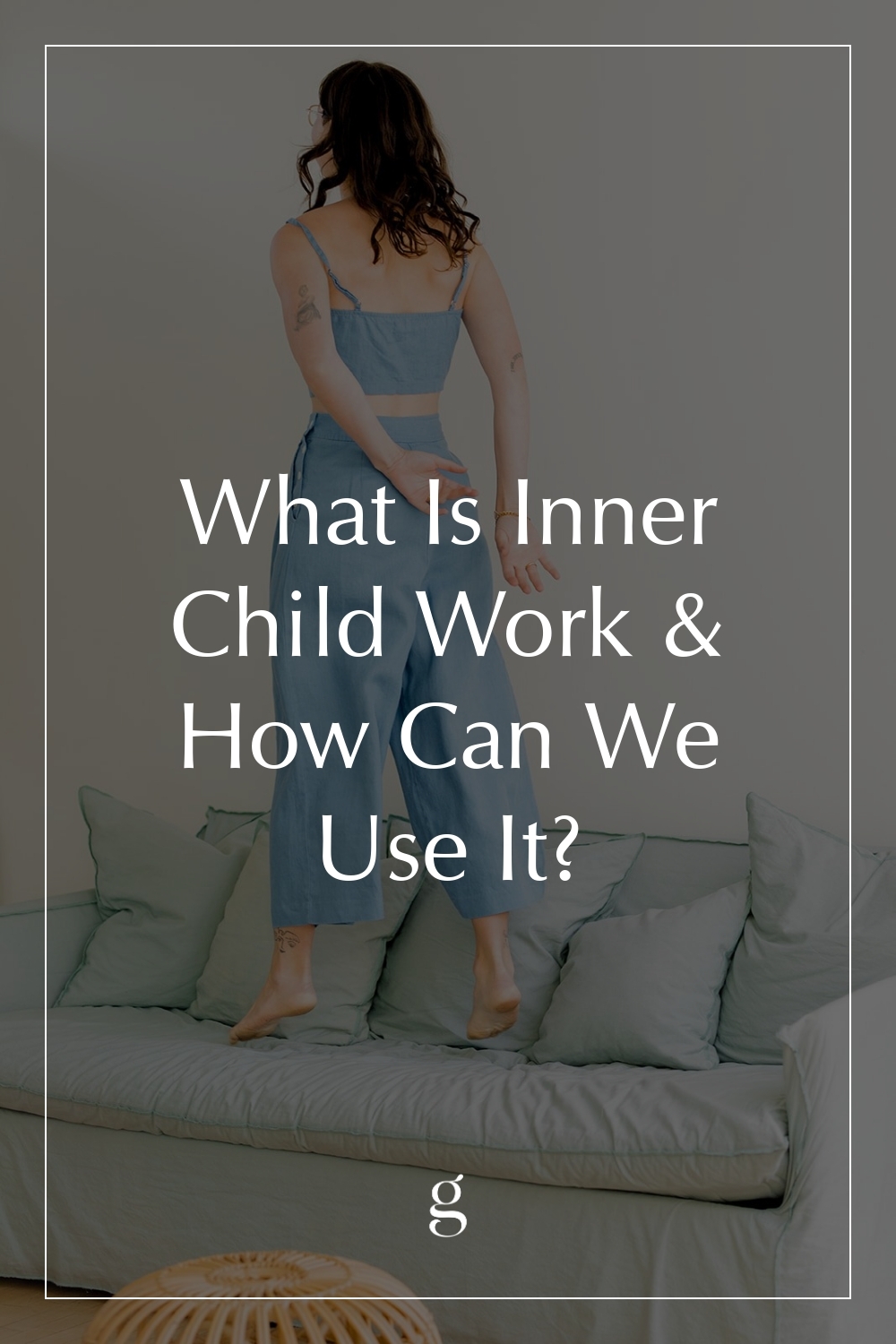
What Is Inner Child Work & How Can We Use It?
Last year, my therapy sessions began to feel like an ongoing carousel ride: every conversation circled the same few topics without arriving anywhere new. No matter the angle we started from, or how much self-awareness I brought to the discussion, my struggles with self-criticism stayed stagnant.
I decided to bring my problems to a local life coach, Catherine Andrews. I had already long relied on her action-oriented advice through her newsletter and podcast, The Sunday Soother, and hoped she could inject fresh energy into my old patterns.
After outlining my initial goal to tackle my inner critic, I was surprised by Andrews’ response. She didn’t say anything about dismantling my negative internal voice. Instead, she said we’d work on repairing my relationship with my “inner child.”
“We all have younger parts within us that stay with us over time and impact how we respond in the present.”
I was a little familiar with the concept already, mainly from popular online accounts by mental health experts like Dr. Nicole LaPerla and Dr. Justine Grosso. Inner child work is based on the idea that we all have younger parts within us that stay with us over time and impact how we respond in the present.
In truth? I wasn’t quite ready to accept that when I got emotionally triggered, it could be one of these younger parts playing out a childhood wound. I wanted to believe that present me is responsible for my behaviors and actions.
But all of us are the sum of our experiences, including past ones. Especially when we’ve repressed emotions and associated memories over time, inner child work can be incredibly helpful in uncovering, processing and healing old wounds. It can also allow us to reclaim joy and more emotional freedom in the present.
What is the Process of Inner Child Work?
According to Andrews, the foundation of inner child work is rebuilding a trusting relationship with the inner child, which requires approaching them as if they were an entirely separate person from your current self.
The stages of rebuilding this relationship include: the discovery of the age of your most wounded younger self; the offering of a safe space to validate and voice their emotions and pain; the tending to and validation of that pain; and finally, the reparenting of the inner child by meeting their inner needs.
“Inner child work takes us back to the source of old wounds so we can ‘reparent’ ourselves and heal old wounds.”
Andrews explains that many of us are stuck repeating childhood coping mechanisms that once kept us safe but have become maladaptive over time. Inner child work takes us back to the source of old wounds so we can “reparent” ourselves and heal old wounds.
Imagine an 11-year old child stepping up to the blackboard in school and completely blanking on the answer, only to have a teacher make fun of them in front of the class.
“When you embody that experience of shame, your brain will want to protect you from that experience by discouraging you from trying new things in order to avoid that feeling again,” Andrews explains. “Maybe as an adult, this protective behavior manifests as perfectionism, rigidity, or never wanting to be seen doing things imperfectly. Inner child work will take you back to that younger version of yourself to give her a voice and offer the loving kindness that should have been offered by a compassionate adult.”
The first step is noticing when your inner parts get activated or triggered so that you can respond as a loving parent, says Andrews. Then, it’s important to create a safe space for the inner child to express their innermost feelings. This may look like giving the inner child space to share deep fears of being forgotten, neglected, unheard or pushed away. They might even want to lash out, or on the other hand, shut down entirely.
“Create a safe space for the inner child to express their innermost feelings.”
This step is less about intellectually analyzing why the child feels this way and more about meeting your experience with nonjudgmental awareness, explains Dr. Barbara Grant, Founder and Developmental Specialist at Nudge and Cradle, a parenting and developmental support organization. The nonjudgmental response is key to re-establishing trust between you and your younger self, creating a way to move past old patterns.
By creating space to witness our past pain and emotions, we can figure out how to “reparent” ourselves and give the inner child the love, gentle kindness, and visibility we missed out on before. Dr. Grosso, a woman’s mental health expert focusing on inner child work, adds that cultivating this more compassionate and firm “inner parent” also helps us show greater emotional resilience and deeper connections in the present.
How to Practice Inner Child Work to Rebuild Inner Trust
We all understand that we should be more self-compassionate, but the “how” can be really tricky. Approaching some of my old patterning through the lens of inner child work finally allowed me to understand better why I struggle with self-criticism in certain situations and create space for more self-compassion.
“While you can do inner child work independently, sometimes you may need an extra hand to serve as your anchor to ground you through the process.”
If you’re looking to start repairing your relationship with your inner child on your own, try out one of these recommended exercises and techniques below.
Of note, inner child work can be especially painful because you’re going to that original source of wounding. While you can do this work independently, sometimes you may need an extra hand to serve as your anchor to ground you through the process. Andrews notes that inner child work can be overwhelming to start with on your own, especially if there was significant trauma or abuse in the past. Finding a therapist, guide or coach can help light the way as you navigate past darkness.
1. Identify Your Inner Child
Dr. Grosso recommends making a list of your emotions, beliefs about yourself and relationships, or the world, and ways that you typically avoid emotional pain.
“Work to recall the fears, struggles, wishes that you had at that age.”
Then reflect: Is there a pattern in what triggers these things? Where did you learn these beliefs about yourself and others?
Work to recall the fears, struggles, wishes that you had at that age. It can even be helpful to find a photograph of your younger self for inspiration. Create a vivid image so that you can better get to know your inner child, nurture them, and meet their needs.
2. Repair Your Relationship
After identifying your inner child and creating a strong picture of them, Andrews suggests the practice of letter writing to cultivate the relationship. Begin by writing a letter to your current self from your child—let your inner child’s voice flow freely on the page, sharing any hurt or unmet needs that have been repressed or withheld for years (perhaps decades). Make sure to witness the experience with as much objectivity and lack of judgment as possible.
“[Make] a little altar to your inner child so that you can be reminded of their needs on an ongoing basis and continue to invest in the relationship.”
Next, Dr. Grosso recommends writing a letter from your current self to that younger version of you. Tell them what they may have needed to hear at that time and offer compassion, understanding, validation, and safety. Practice compassion and think of yourself as a caregiver or mentor for your inner child.
Andrews also suggests making a little altar to your inner child so that you can be reminded of their needs on an ongoing basis and continue to invest in the relationship. This altar could include a photo of yourself at that specific age, flowers or a plant, candles, crystals, and/or objects you loved when you were younger—like a special stuffed animal or toy. By creating this physical space, you can help yourself connect and care for your inner child on an ongoing basis.
Just remember: as with any other relationship, your inner child won’t become your closest confidant and trust you overnight. They might not want to “open up to you and share [their] deepest fears right away,” Andrews explains.
3. Create Trust By Checking In
As you undergo this relationship-building process, Andrews recommends checking in with your inner child every day (or week) over a month or two. While you might think this work can be done quickly, ask yourself, how long would it take to actually cultivate a trusting relationship with a skeptical child?
“[Check] in with your inner child every day (or week) over a month or two.”
Andrews herself practices saying hello to her inner child on the page every morning. She allows her inner child to express her needs and then writes back (as her adult self) to address how she will care for the child’s needs or worries.
She says: “Inner child work is about expressing a concrete plan in response to your innermost needs. The more specific the better! You prove how you will take care of yourself through your words, and then you earn that trust every day with your actions.”
4. Express Yourself
Dr. Grosso suggests that practicing self-expression and letting go of inhibition through dance or yoga can be a really powerful practice to rebuilding trust, especially if you have an inner child shame wound. You can tell if you have an inner child shame if you routinely have thoughts like, “I shouldn’t take up space,” “It is wrong to express myself,” or “I am inherently unworthy.”
She advises finding a safe place to do these practices where you won’t be interrupted and where it feels okay to make noise. You can put on your inner child’s favorite song or any music that feels supportive to being more of your true self. Then, while dancing or practicing yoga, tune into your body’s intuitive urges to move. Dr. Grosso notes that you may notice emotions or physical sensations arise—allow yourself to stay with them and move through them if it feels safe enough. Honoring your body’s movement will let your inner child feel more safe to emerge.
“When we start to examine our wounds from the past and heal them, we can make more progress in the present and show up with more authenticity and confidence.”
When we start to examine our wounds from the past and heal them, we can make more progress in the present and show up with more authenticity and confidence. Continuing to dialogue with and take care of your inner child can help you not only better care for yourself, but also embrace the messiest parts of your humanity—which then encourages others to do the same.
What ways can you show your inner child some love? I’d love to hear how your inner child shows up for you, and how you plan to rebuild some trust in the comments!
Carolyn Rivkees is a DC-based writer and brand advisor focused on making well-being more accessible, less lonely and easier to understand. She is the voice behind Chronically Cheerful, an IG community that informs and inspires others living with health challenges. Read more of her writing over at her newsletter!





